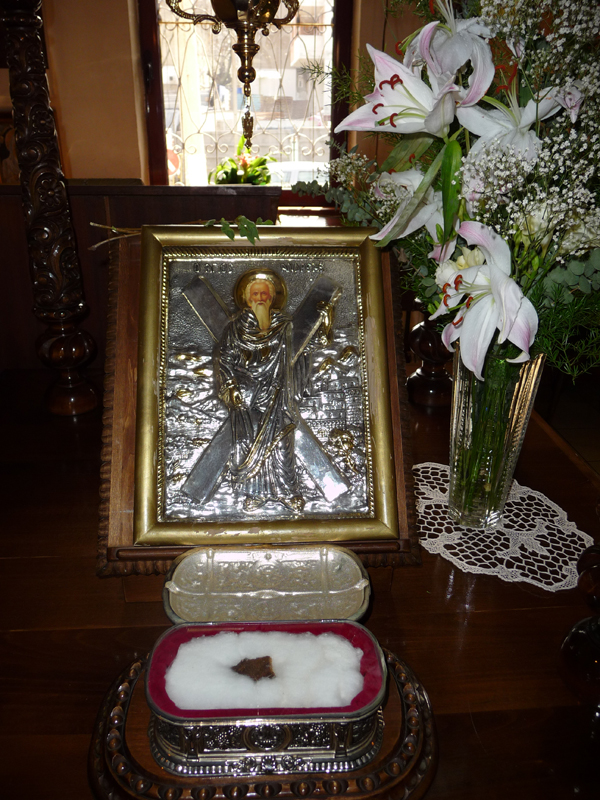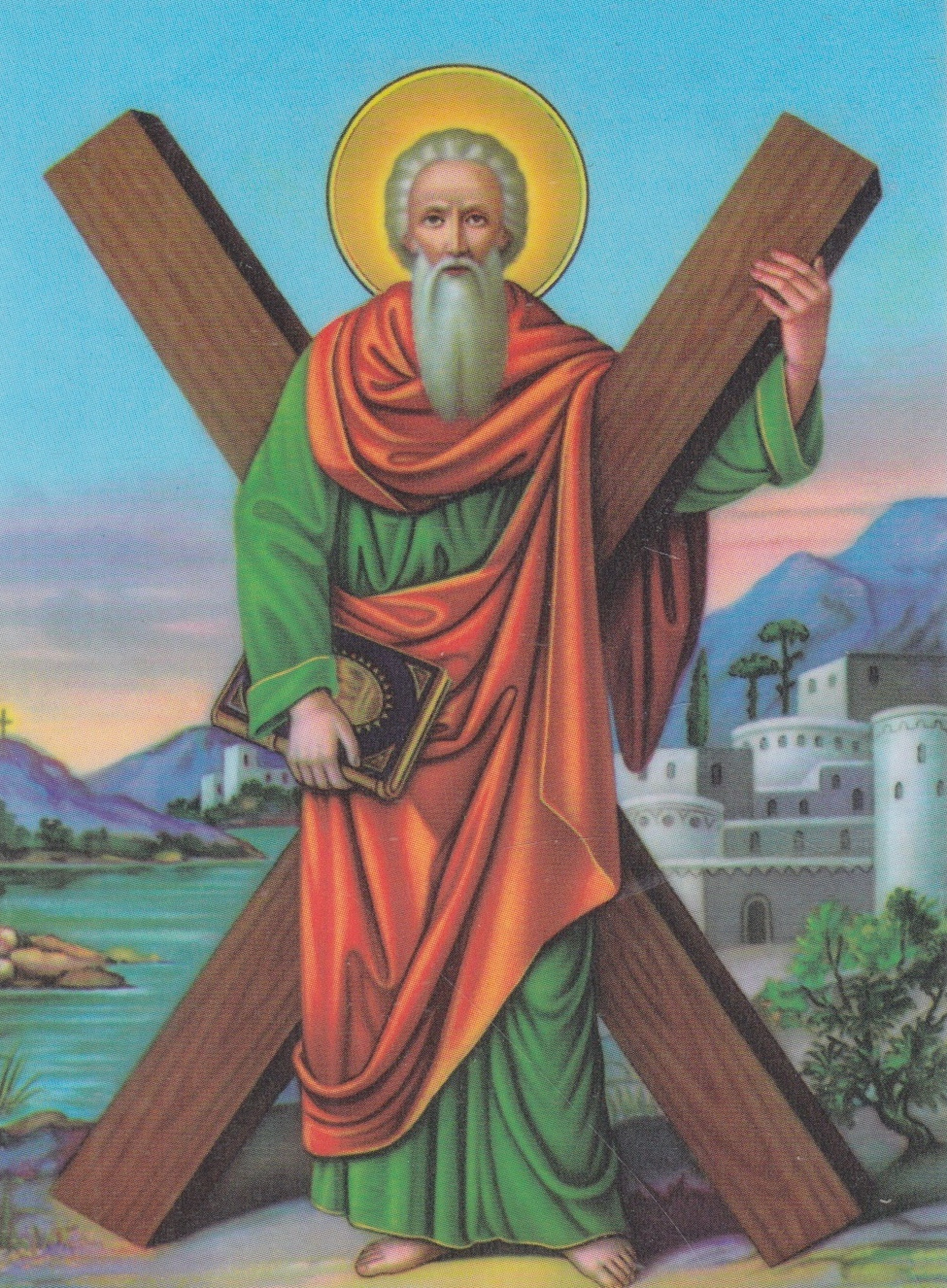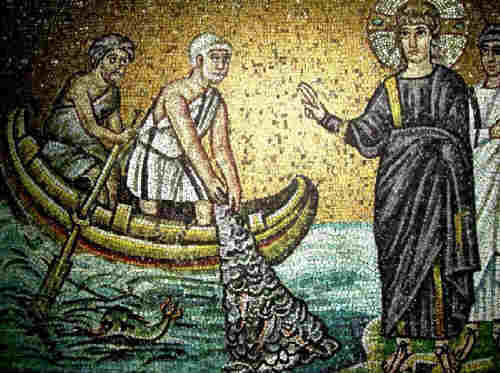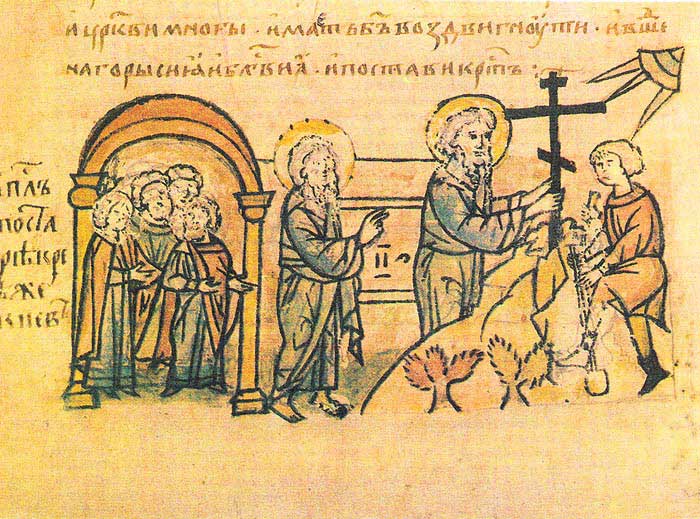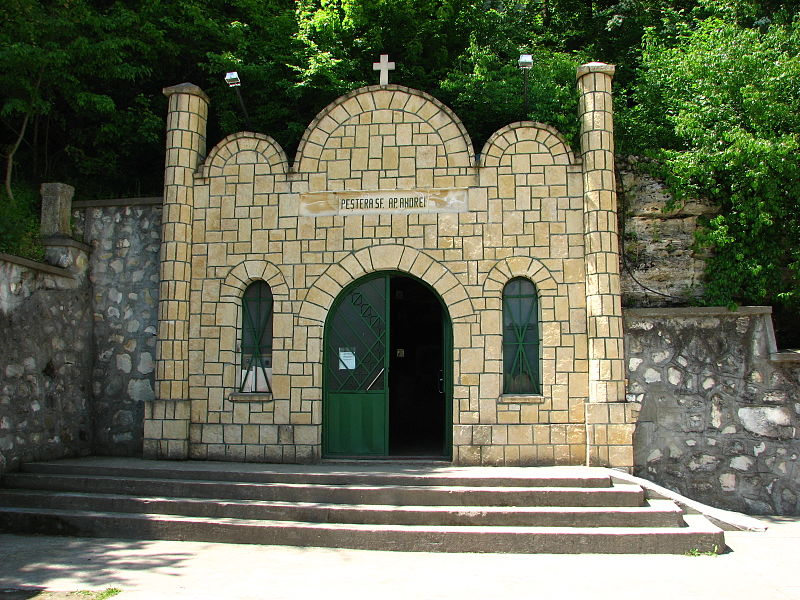![]()
Why saint Andrew the Apostle is special for the Bulgarian Orthodox Church
and the Eastern Churches?
According to Church tradition saint Andrew the Apostle the First-called was the apostle from which wide areas of the Eastern lands was christianized, by his fervent preach of the Gospel and the good news of the Resurrection of Christ who suffered on the Cross for the salvation of mankind.
The Ecumenical Patriarchy of Constantinople and the Ancient Eastern Byzantium Church has received its apostleship in practice, exactly from st. Apostle Andrew.
During his apostleship mission saint Andrew has preached the Gospel and gave the faith for a first time in the Ist century according to Church tradition, as he passed by the Black sea borders, today part of which are in Bulgaria, he went through Romania, where he has spent some time living as a hermit in a cave and then up to Kiev and Scythia, where he made a prophecy that the Christian faith will put its Roots and that soon the pagan tribes of Kiev lands will accept the faith and put the Cross high over their lands.
When Bulgaria was later Christianized by saint Boris-Michael, and the Holy Bulgarian church was established on this lands thanks to the missionary works of Saint Kiril and Methodius, Saint Kliment of Ohrid, saint Gorazd, Naum, Sava, Angelarius and whole pleade of saints and teachers, Bulgaria has received, also the gift of priesthood and apostleship (has received its own hierarchy of bishops governing the Bulgarian Orthodox Church), thus by spiritual line the Holy Spirit here in Bulgaria was received from Saint Andrew, later this enlightnements achievement, the Books in Church Slavonic, the services and most importantly the Cyrllic alphabet was transffered from Bulgaria and later Serbia to the endless steppes territories of capital Kiev that was a capital of the Rus at that time and in all Scythia today the territories of Russia. Thus all the Byzantine Eastern Churches and Bulgaria
After the end of the persecution of Christians, in the 4th century AD, Saint Equal-to-the-Apostles Emperor Constantine the Great began to erect numerous Christian temples.
Among them was the temple of the Holy Apostles in the new capital of the empire – Constantinople. After the death of St. Constantine in 337, his son, Constantius, ascended the throne.
The new ruler, fulfilling the will of his father, decided to bring to the capital of the empire the holy relics of the Apostles Andrew, Luke, Timothy and lay them in the church of the Holy Apostles, where the Equal-to-the-Apostles Emperor himself was buried.
Originally, the holy relics of Saint Andrew the First-Called rested at the place of his martyrdom, in Patras, in the Peloponnese, Greece. According to Western tradition, a few days before the relics were transferred to Constantinople, Regulus, who was guarding them, removed the lid of the sarcophagus in which the relics of the Apostle rested, separated from them one shoulder, three fingers of the right hand, part of the knee and a tooth.
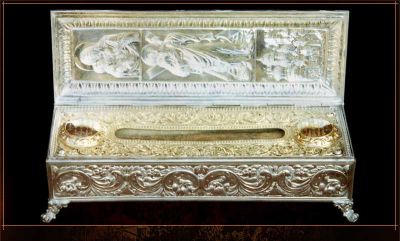
Holy right hand of saint Andrew the First-Called
With these relics Regulus left Patras and set out to preach the Gospel among the pagans inhabiting Scotland.
The inhabitants of the country welcomed the enlightener with great honor and together with their King accepted Holy Baptism.
In Scotland, the first Christian church was built in the name of Saint Andrew, in which parts of his holy relics were laid. Which played the role for Scotlands patron saint protector to become Saint Andrew the Apostle.
The deposition of the holy relics of Saint Apostle Andrew the First-Called in Constantinople took place on May 3, 357 in the presence of the Patriarch of Constantinople Macedonius I and Emperor Constantius.
In the 9th – 10th centuries, the Byzantine autocrats usually sent as a donation for the built monasteries and temples parts of the holy relics that rested in Constantinople, including the relics of the holy Apostles.
In the second half of the 9th century, following an urgent request and special intercession before the emperor, the honorable head of St. Apostle Andrew the First-Called was delivered to the St. Andrew's Church in the city of Patras, where it rested until the middle of the 15th century.
In 1460, to the walls of The army of the Ottoman Sultan Mohammed II was approaching the town of Patras. The Governor /Archon/ of the city of Patras, Thomas Paleologus (brother of the Byzantine Emperor Constantine XI, who died during the capture of Constantinople by the Turks in 1453, father of Princess Sofia, the future wife of the Grand Duke John III of Moscow), losing all hope of preserving independence of the city, took the precious and holy treasure of the city from St. Andrew's Church and arrived in Rome with it to collect funds and forces for the liberation of the Orthodox Christian East from the yoke of the infidels.
The holy head of St. Andrew the First-Called Apostle was in Rome until 1964, when, by the decision of Pope Paul VI, this shrine together with parts of the cross of St. Andrew was returned to the Greek Orthodox Church.
Now these relics are located in one of the largest cathedrals in the Balkans, Saint Andrew the First-Called in Patras, Greece, i.e. in this place where the first disciple of Christ preached and ended his martyr's earthly life.
![]()
X shaped cross of Saint Andrew according to medieval tradition
The honorable head of the Apostle rests on the throne in a silver coffin, and behind the throne – saint Andrew's cross-relic (according to middle-ages tradition to be X shaped cross) in which are embedded parts of the real cross of Saint Andrew, on which he was crucified.
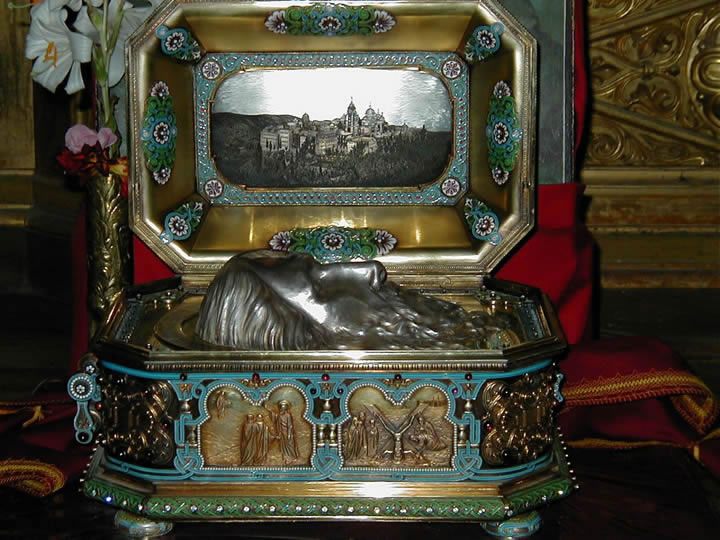
Mount Athos received the hand of St. Andrew as a gift in the Great Lavra of Athos, founded by Saint Athanasius (the Great) at the request of his friend and companion and patron of the Byzantine emperor Nikephoros Phocas (963-969).
Parts of the holy relics of holy Apostle are also kept in other monasteries on Mount Athos.
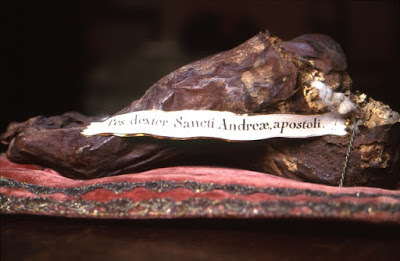
Foot Relic of Saint Andrew the Apostle
Likewise, part of the forehead bone is kept in the Saint Andrew's hermitage (scythe), in the scythe of saint Prohet Elijah is preserved the foot of the Apostle.
This walking stick was given in 1806 by Hieromonk Dionysius /in Kyzikon (Kyzicheska) Diocese/, who left the eparchy with these relics from the monastery of Saint Marina, cause the monastery was
looted and sacked by the Turks.
In the Russian monastery of Saint Panteleimon on Holy Mount Athos, the second foot of the First Called Disciple of Christ is preserved.
Part of the relics of Saint Andrew also rest in the nun's monastery dedicated to his name, which is located on the island of Catalonia in the village of Peratata.
Fragments of the honest relics of the Apostle are also found in the monastery of Saint Nicholas on the island of Euboea.
Material written from sources according to information from the Holy Kiev-Pechersk Lavra, on the occasion of the stay from June 27 to 29, 2003 during which the the foot of St. Andrew the First-Called, was given for veneration from the monastery of saint Panteleimon, Mount Athos.
Transferring a part of the relics of Saint Andrew to the church dedicated to Saint Andrew in Sofia, Bulgaria
In 2001, the Metropolitan of Patras, Greece at that time Nicodemus, presented a piece of holy relics from the knee of Saint Andrew and a cross in which pieces of the cross on which St. Andrew the Apostle was crucified were placed.
On November 29, 2001, on the occasion of the feast of St. Andrew the First-Called, the Reliquary was carried in a litany procession from the Bulgarian Church Synodal Palace to the capital church "Свети Андрей Първозвани / (Saint Andrew the First-called)".
A Holy Liturgy was served which was attended by Their Eminences the Metropolitans: Metropolitan Kiril of Varna and Great Preslav, metropolitan Joseph of America and Australia, metr. Gelasius of New York, metr. Grigoriy of Velikoturno, metr. Neophyte of Dorostol and Cherven (currently Patriarch of Bulgaria) , metr. Gavriil (Gabriel) of Lovchan eparchy, His Eminence Bishop Nikolai of Znepol (then) and now metropolitan of Plovdiv, Patriarchal Vicar, Archimandrite Boris, the secretary of Holy Synod, numerous priests, the graduates of the Sofia Theological Seminary "Saint Ivan Rilski" and many laymen.
When the litany reached its destination, the church "Stsaint Andrew the First-Called", the relics were welcomed, received and placed in the church for worship by Patriarch Maxim (Rest In Peace). Immediately after that, Great Vespers with five loaves of bread as the orthodox tradition is, was served by the Most Reverend (then) Bishop of Znepol, Nikolay, together with Archimandrite Boris and the temple clergy. The Most Holy Patriarch Maxim (already in his 90s) and some of the bishops attended the service in prayer. After the service, the relics remained exposed for worship in the House of God, which was also open at night. It should be noted that this was the only Orthodox church in Bulgaria dedicated to saint Ap. Andrei.
Also, the fact that for the first time the relics of St. Apostle Andrew are coming to our country is important. Part of the relics were transferred to the church on the island of Saint Anastasia near Burgas in the diocese of Sliven.
The reason for the transferral of relics to st. Anastasia is that according to tradition, the Apostle Andrew himself passed through this island in his apostleship mission.
Every year on November 30 – Saint. Andrew's Day, in the church the holiday is celebrated with a solemn Holy Liturgy, celebrated by His Holiness the Bulgarian Patriarch and Metropolitan of Sofia (today Neofitos), and in his absence, by a bishop, visiting clergy and the church clergy.
From materials from Church newspaper (official newspaper of the Bulgarian Orthodox Church)
